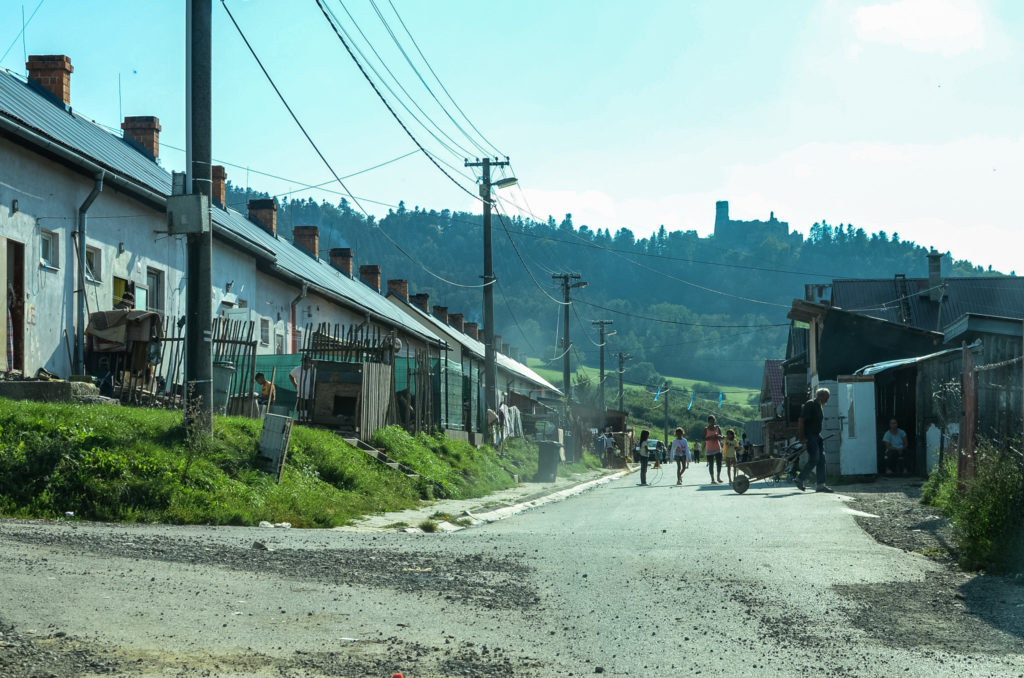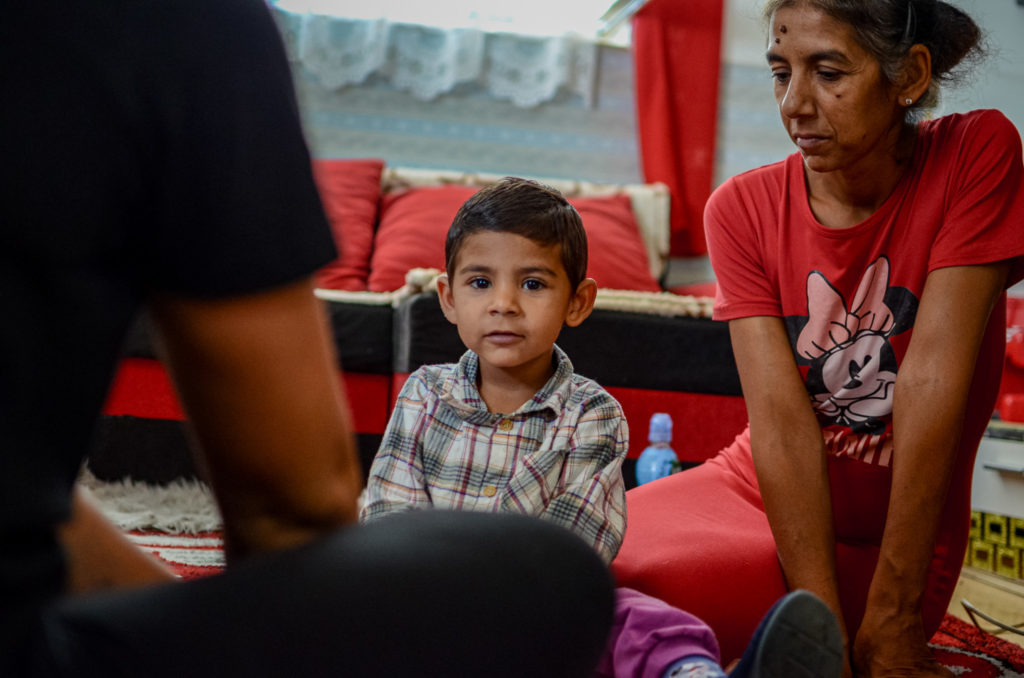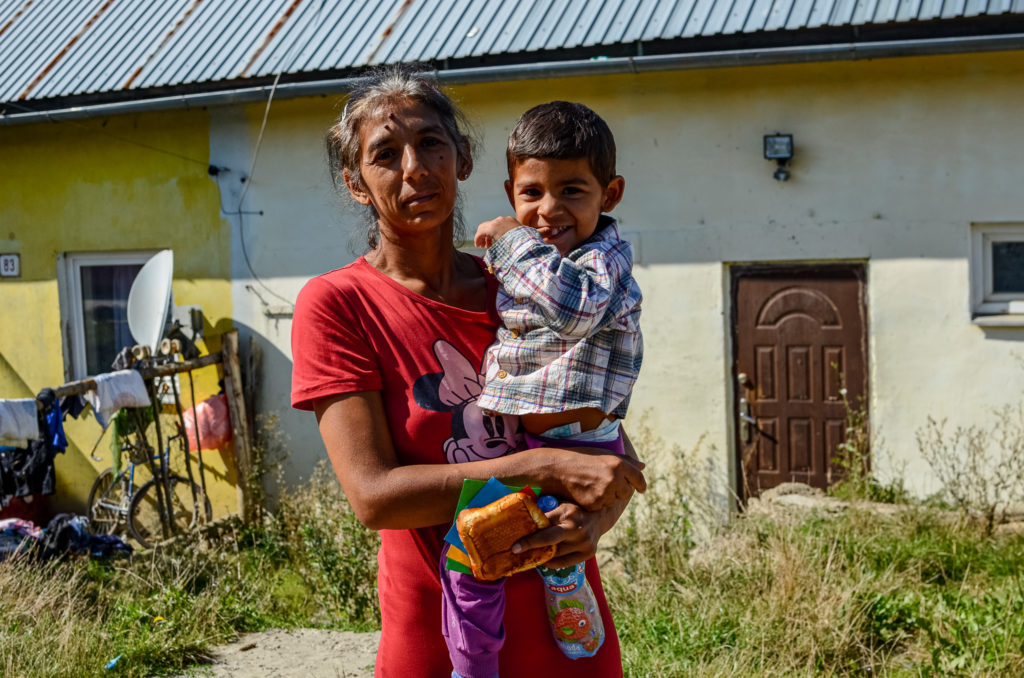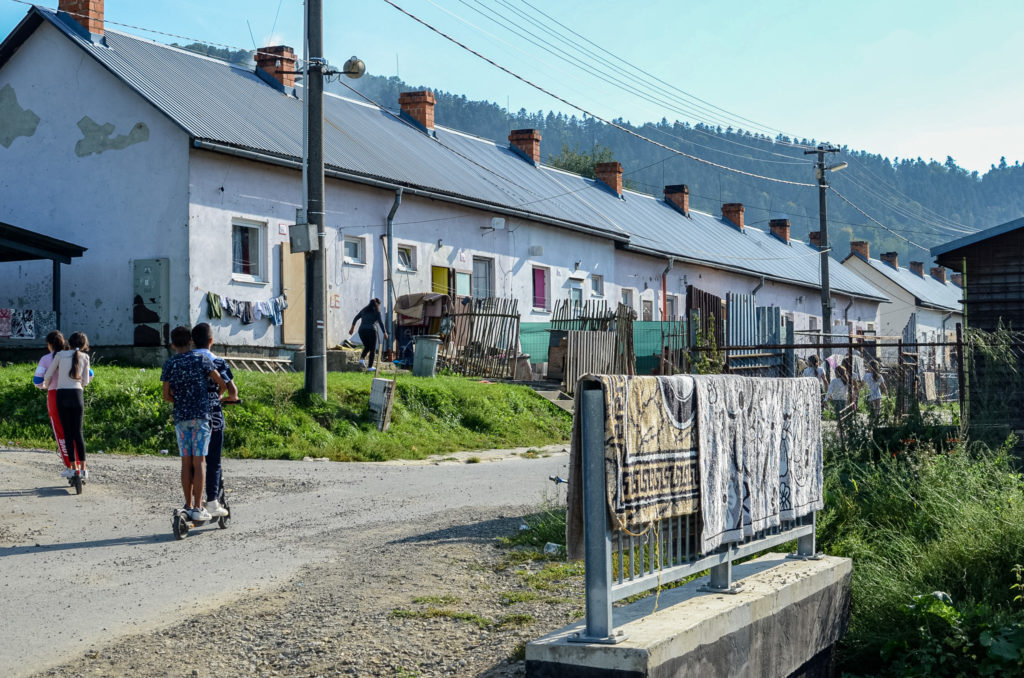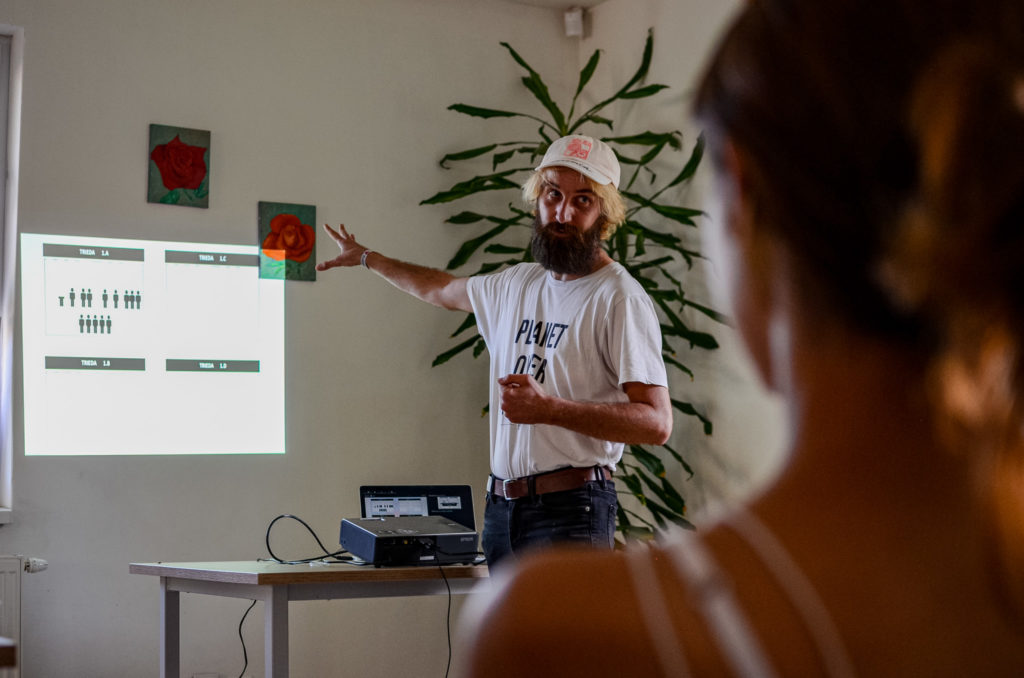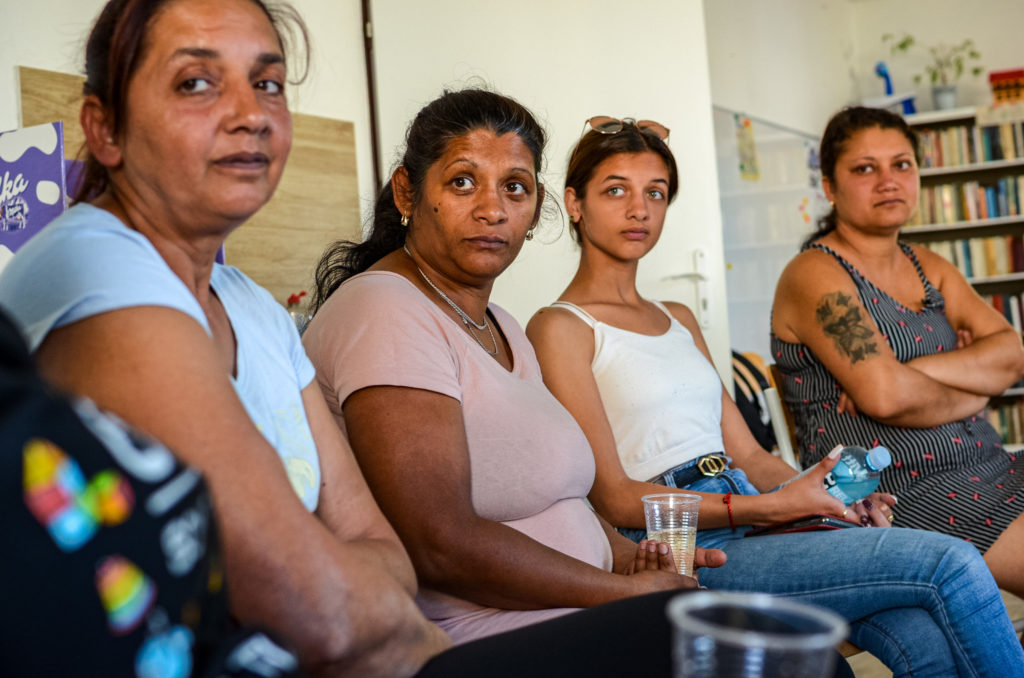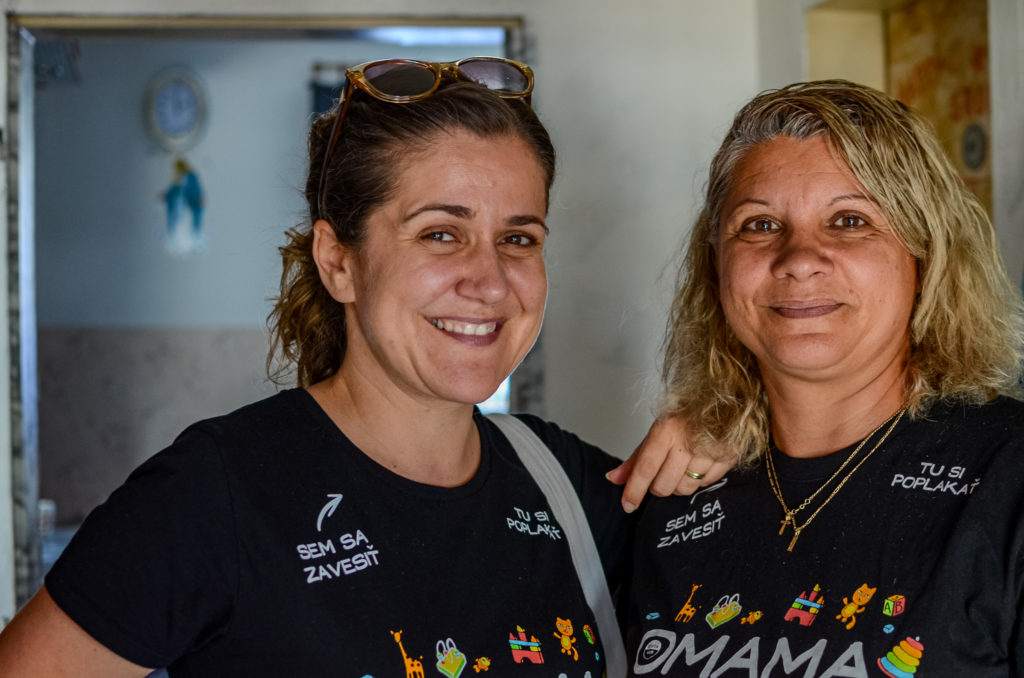The first six years of a person's life are crucial for neurodevelopment. Growing up in poverty can negatively impact your health, behaviour and future. Such is the case for Roma children living in segregated settlements in Slovakia, who are already far behind their peers before they even enter the educational system - where they subsequently face discrimination. Women from Roma communities, so-called "omamas", are helping Roma parents to change this.
To get from Bratislava, the capital of Slovakia, to the village of Zborov which is 500 kilometres away, it takes a whole day, sometimes two, depending on the unreliable public transport. In Slovakia, we joke that these places are where foxes come to say good night or that they are the end of the world. In a way it’s true, the privileged middle class stops at the outskirts of this village on the Slovak-Polish border.
Socially disadvantaged families do not live directly within the municipality, with its shops, schools, clean streets and well-kept gardens. Several decades ago, their ancestors were forced by state institutions to build their homes outside of the village which led to segregation and thus generational poverty. Slovaks call this area settlement, Roma people call it Vatrisko, which means a big fire to sit around and tell stories.
Playing against poverty
I arrived in the neighbourhood curious to meet women known as omamas, which means grandmothers in Romani. Since 2018, these members of the local community have been helping parents of children under the age of six, with the child’s development, to prevent school failure in the future. Guided by one of the omamas’ mentor, Patrícia Dzuruš, who is half Roma herself, I was able to enter the community without creating too much of a stir, which is rare. The Roma minority in Slovakia experience constant disrespect from the rest of the population, including the media. I’m a gadjo, non Roma person, and trying not to stand out is simply impossible.
“I didn’t grow up in a settlement, neither did my father, but his ancestors did,” Patrícia explains while we walk between bricked and shanty houses. “My grandfather was a well known blacksmith, thanks to his hard work he managed to escape poverty and buy a small house in town.” Two generations later, the university educated Patricia supports three omamas in Zborov and builds bridges between two distant worlds, that of the Roma minority on one side and the rest of the population on the other. She knows there are lots of prejudices on both sides about ‘the others’.
A newly constructed road makes the heat unbearable, however, omama Inge Ferenc’s concrete house provides some pleasant shade. She welcomes us with a smile, making us feel immediately at home. The silent atmosphere is broken as soon as a small, curious boy arrives with his mother. Three year old Emir is bursting with excitement to begin the lesson but he has to wait until I introduce myself to him and his mother, Jarka.
"Although I try my best not to interrupt the lesson, Emir's eyes keep on following my camera whenever I move."
Afterwards we all sit down on the floor and omama Inge shakes some tiny bells to signal that the lesson has just started. Firstly, she shows Emir a green oval pictured on a white sheet of paper. She asks him to describe whether it is big or small, placed up or down, on the right hand or on the left hand side of the paper. The activities are short and fun to attract the child’s attention and every correct answer is applauded by Emir and omama. Although I try my best not to interrupt the lesson, Emir’s eyes follow my camera whenever I move. This makes me feel a bit nervous, although, I soon realise that I’m probably the only person in the room feeling uncomfortable.
Inge is a trained professional who gives similar individual lessons to 25 children from her neighbourhood in Zborov every week. She teaches the children either in her own home or at their houses. Working this way requires the ability to stay focused in constantly changing conditions. Her eyes patiently observe Emir’s behaviour, which indicates his emotions and needs at every moment. Soon, she engages Emir in the next educational activity.
Inge Ferenc was one of the first Roma women to be approached by the Cesta Von (the Way Out in English) organisation and trained as community educator in Slovakia. In 2022, the European Social Fund and the Ministry of the Interior of the Slovak Republic supported the NGO with a 433.790 € subsidy and five years after the Omama programme began, it is providing regular income to 44 omamas and 24 mentors in three dozen underprivileged communities. Thanks to their efforts, more than 900 children receive help in developing basic motor skills, cognitive abilities and language proficiency. Standardised lessons are held in the Slovak language, which is crucial for the children’s future education and potential employment. Mothers are essential participants in this mission, they learn from omamas how to engage with their children as well as how to create educational tools from easily available materials, such as plastic bottle caps or coloured paper.
Before Emir’s lesson ends, they read the story of The Very Hungry Caterpillar, written by the internationally renowned illustrator, Eric Carle, and loved by children all over the world for generations. Emir listens to how a greedy animal gradually eats through one apple, two pears, three plums… and it is still hungry! The book serves to practise numbers, names of weekdays, shapes and also colours. Emir hesitates with some names of food; children living in poverty rarely see oranges or cupcakes. With a little help, he finally recognizes them and is clearly proud of himself. The lesson ends with laughter and applause from everyone.
Generational poverty
Growing up in a socially excluded group, neither parents, nor grandparents experienced playing with such luxuries like toys or children’s books. “Children didn’t know what a book was, some cried when they first saw it,” Inge laughs remembering the challenges she faced. Generational poverty means that neither of the past two generations of family remember how it feels to live in safety, wealth and good health. Psychologist Shoshana Chovan investigates the effects of insufficient nutrition or constant stress on the development of children growing up in generational poverty.
“When they do not have sufficient energy intake from food, they lack the energy to move and develop motor skills. If they move less, they explore the surrounding environment less and learn less about it. They are also affected by the fact that they are carried around for a long time so that they don’t play on a dirty floor (which is common in make-shift houses, ed.). Therefore they don’t have as many opportunities for quadrupedalism, which affects the development of right-left coordination. Later on in school, they may have difficulties with writing, i.e. with hand-eye coordination,” the researcher explains. The same goes for children growing up in a Brasilien favela, Kenyan slum or urban ghetto in France, generational poverty influences children’s health, behaviour, and future.
Omamas empower parents to break this vicious cycle by taking action in their children’s pre-elementary education. Inge remembers the early years of the programme very well, she went from door to door convincing parents to enrol their toddlers in a new educational programme. “It was really, really difficult! They were unnecessarily worried about getting into trouble with social-legal protection and losing social support, when they signed up”. The situation has definitely changed since then, nowadays, parents ask her whether she can teach more children.
Jarka, Emir’s mother, joined the programme at Inge’s invitation. She is well aware of how important education is. “I’m thankful for everything my children have learnt from omamas. I don’t have much time to teach them, I have many children and a household to take care of,” she says. Her five-year-old daughter already attends communal kindergarten together with non-Roma pupils. Thanks to the omamas, the girl has adapted to the environment very well, which is often not the case as Roma children are usually segregated once they enter the state educational system in Slovakia. Jarka has high hopes that the programme can support Emir in the same way. As well as her own two children, she is raising five more step-children in a very basic, small wooden house. Jarka spends most of her time alone with them since her husband travels for work, and when he returns the house becomes even more overcrowded and stressful. “Sometimes he helps me with the children, but not very often… until he gets drunk,” she admits quietly.
"Although they might get invited to personal interviews, when potential employers see their skin colour, the jobs are often suddenly taken."
Roma men from Zborov often work abroad as they find it almost impossible to find employment in Slovakia. Although they might get invited for interviews, as soon as potential employers see their skin colour the jobs are often suddenly taken. “It happened to my husband as well,” Jarka explains. She worries whether their life situation will ever improve. I try to cheer her up by telling the story of a golden fish that can fulfil any kind of wish. What would make her happy, I ask. “To have a big house,” she replies without hesitation,” and adds: “I don’t want anything for me at all. My only wish is that my children have a better life.”
A better life for Jarka and people living in poverty means fulfilling the most basic human needs. Lack of efficient social support doesn’t make it any easier to achieve this goal; nine members of Jarka’s family survive on less than 400 € per month. They also have no access to drinking water, which Jarka must subsequently retrieve from elsewhere. “Fortunately, our people support each other,” she says proudly. “If I run out of either flour or oil, or even money, someone always helps me. They know I’m going to pay them back.” Before we say goodbye, I wish Jarka the best of luck, hoping that her future won’t depend purely on other people’s good will.
Education and exclusion
According to the the Slovak Republic Ministry of Finance’s report, every sixth person, or 16.3% of the overall 5.4 million population of Slovakia, was at risk of poverty or social exclusion in 2018. It mainly concerned children from excluded areas, Roma people living in marginalised groups, single parents with children and people with disabilities. The governmental document warns that since the Slovak education system does not integrate most of the children from socially excluded groups, the tools put in place to improve the situation only end up helping 50% of those concerned.
When there is news concerning the minority, the Roma people shown are usually illiterate adults, half naked, with dirty children and stray dogs wandering in between make-shift houses in settlements.
In Slovakia, a false image of Roma people draining the social system is wide-spread. The media play a role in creating this picture, as do politicians. Whenever there is a news piece concerning the Roma minority, the people who are shown are usually illiterate adults, with dirty half naked children plying in the mud and stray dogs wandering in between make-shift houses. “Out of 420,000 Roma people, more than half are integrated within the general population,” says Tomáš Hrustič, a social anthropologist from the Slovak Academy of Sciences. “The rest live in segregated areas, for example, one street within a certain village will be inhabited exclusively by Roma families. The majority of Roma people do not live in poverty though.” He estimates that there are around 250 settlements in Slovakia with about 30,000 people living in them, which is the population of a small Slovak town. “If the policies in place were sensitive enough (towards the needs of this minority), building infrastructure in these settlements would not be expensive,” he adds.
Another omama, Vierka Kováč, awaits me and her mentor Patrícia Dzuruš, shortly after finishing the morning shift. We sit in the kitchen, considered to be the heart of every home both by Roma and gadjo families. She serves us a slice of homemade cake alongside coke and sweet orange soda. “Roma people do not drink white water!” she jokes. I therefore opt for coke instead of tap water which I can drink everyday.
No adult men are present, Vierka’s husband left for work in Czechia, her son works in Germany. She misses them a lot. Fortunately, a bunch of grandchildren and two jobs keep Vierka busy. Besides teaching children as an omama, she works in a public kindergarten as a qualified assistant and hopes to finish her pedagogical studies next year. She plans to apply for a permanent work position as pre-primary school teacher.
“I hope my colleagues will accept me as an equal partner. I can also teach children even if I come from Vatrisko.”
“I study so that I can stay in Zborov and help my people. I hope to open their eyes and hearts so they see that even being poor and being Roma, we can achieve the goals that we aim for. We just need to be stubborn and keep on going for it,” Vierka says. She hopes to achieve her goal of becoming a kindergarten teacher in their local school. “I hope my colleagues will accept me as an equal partner. I can also teach children even if I come from Vatrisko.” Vierka has brought up her three kids in a make-shift house and she remembers only too well how hard life can be when you don’t have any ingredients to cook lunch. These experiences, however, now help her to look at her fellow mothers without judging them.
Vierka thinks that society should be more aware of the burden mothers from segregated areas carry. “For example, if a child does not go to school, it is considered the fault of the mother. But what if she doesn’t have the shoes or warm clothes to be able to send him to school? Or if the children smell, no one asks why. Perhaps their mum had to wash their clothes in a creek because she doesn’t have a washing machine. Maybe she didn’t have money to buy washing powder,” she explains. When we met for the first time two years ago, Vierka had already come to the conclusion that “every mother would give anything for her children to have a better life than herself.”
Breaking the vicious cycle
Lack of awareness, however, is not the only challenge in changing the future of underprivileged children. Until 2022, the Slovak government had not provided any support with regards to the early development of children from socially excluded families. Therefore, the effort to better their situation lay on the shoulders of NGOs like the Way Out… or even passionate individuals like, for example Juraj Čokyna, a former journalist and now educator. In the late afternoon local mothers and omamas join him in a community centre in Zborov to have a discussion about what should be done. Parents are desperate for their children to go to schools where they are treated with respect and consideration instead of humiliation or even physical violence. Čokyna has organised similar meetings in three other segregated areas and has heard pretty much the same things at each of them.
This is no surprise to Juraj who used to work in a segregated Roma school within the Teach for Slovakia programme which recruits promising leaders to teach for a period of at least two years in marginalised groups. He wrote a book about his experience for the general population and is now working on another publication for Roma parents that will offer strategies on how they can protect children from failure within the discriminatory school system.
Bearing in mind the fact that human brains develop the most during the first two to three years of life, children need to receive adequate support long before they enter school. To prove the positive effect of the Omama programme, the Way Out organisation evaluated children’s neurodevelopment in cooperation with the University of Oxford. They compared two-year-olds from the programme with toddlers from the general population and from segregated communities who did not receive any intervention. Michelle Fernandes, a researcher and paediatrician from the University of Oxford, confirmed that children from the Omama programme achieved significantly better results in the areas of cognition, fine and gross motor skills and language than their peers from the settlements who are not in the programme. However, they still lag behind the children from the general population, Fernandes underlines, and there is still work to be done.
In 2022, the government eventually approved the National Strategy for the Development of Coordinated Early Intervention and Early Care Services for 2022 – 2030 that includes early childhood education support for marginalised families. The Recovery and Resilience Plan explicitly mentioned the Way Out organisation and the Omama programme as an example of good practice. Similar local educators are supposed to be trained – under a different name – in the areas that omamas do not cover due to limited capacities.
Patrícia Dzuruš is not surprised that omamas are now seen as a model by the institutions: “Our programme helps to increase public awareness on how crucial the first three years of children’s lives are.” Her family history is living proof that a way out of generational poverty exists. But also the fact that without external support some things may be lost on the way; neither she nor her father speak the Romani language. Living within the general population, her grandfather found it to be a disadvantage. Although she didn’t grow up in a settlement, Patrícia learnt how hard it was from family stories and has always “wished to be part of positive change”. Therefore, decades after her grandfather left, she goes back to the settlements in order “to support these people in finding opportunities and believing that a different life is possible”, no matter what language they speak.
This story is part of the YOUTHopia campaign, a journalistic project shedding new lights on the EU Cohesion Policy.


